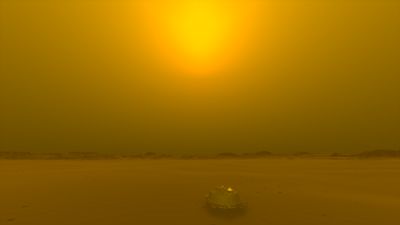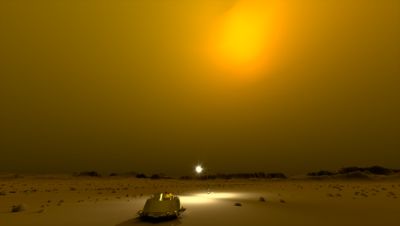-
-
학생용 무료 소프트웨어에 액세스하기
차세대 엔지니어에게 힘을 실어주는 Ansys
학생들은 세계적 수준의 시뮬레이션 소프트웨어를 무료로 이용할 수 있습니다.
-
지금 바로 Ansys에 연결하십시오!
미래를 설계하기
시뮬레이션이 다음 혁신을 어떻게 지원할 수 있는지 알아보려면 Ansys와 연결하십시오.
국가
무료 트라이얼
제품 및 서비스
학습하기
회사 정보
Back
제품 및 서비스
ANSYS BLOG
December 12, 2018
Simulations Let You Experience the Surface of Titan
Have you ever wanted to see an extraterrestrial surface? You can!
No, I’m not talking about a trip to Vasquez Rocks — Star Trek’s Californian stand in for every planet in the galaxy.
Instead, you should check out Titan — Saturn’s largest moon. It turns out engineers can take the data from the Cassini spacecraft and translate that into images of Titan’s surface.

A simulation of the surface of Titan made with Ansys Speos
Titan has captivated the minds of space lovers everywhere. Why? It’s big, it’s gorgeous and even though it hangs out with the outer planets it manages to have liquid water. A whole subterranean ocean, in fact!
However, no real-life images exist of the moon’s surface.
A lack of surface images was a challenge for Last Call for Titan’s documentarians Frédéric Ramade and Jonathan Tavel. However, the pair discovered that the developers of Ansys Speos could help them bring Titan’s surface to life.
See for yourself. You can watch Last Call for Titan at the bottom of this blog.
The question is, how do you take raw data and turn it into a realistic image of an alien moon?
How to Simulate the Surface of a Celestial Body
The Speos software helps engineers simulate the interactions between photons, objects, sensors and the environment.
Traditionally, it is used by engineers to simulate heads-up displays, lidar and other optical systems — like a camera.
Speos can even simulate images seen by the human eye. This tool helps engineers look at their designs through the eyes of their customers.

This simulation of the surface of Titan shows what it would look like to watch an LED light source in the distance. Is it friend or foe from the liquid water lake beneath your feet?
For instance, if you’re fresh out of college with perfect vision, you can still experience your design through the eyes of a 60-year-old with color blindness. This will help you tailor designs to your target audience.
So, if Speos can simulate an eye on earth, the only thing stopping it from simulating an eye on Titan is the environmental variables that affect the behavior of light near the planet’s surface.
Cassini’s data was used to model the terrain and environmental effects on Titan. The terrain is modeled from a reflectance function and areas indicated to be dark by Cassini’s sensors. Engineers then added a few pebbles for effect and texture.
The haze was then modeled from the environmental data collected from Cassini. This information helped engineers determine absorption and scattering sources — such as methane and aerosols.
The team even added LEDs in the background of some images. These LEDs show you what it might look like to see signs of life on the planet.
It would be a haunting and scientifically game-changing event if Earth’s first explorers to Titan saw such a sight. But until then feel free to dream about the event with these images.
To learn more about the visual simulations of Titan, or how to simulate other images using Speos, watch Last Call for Titan below: